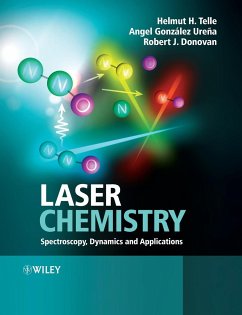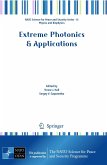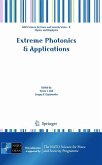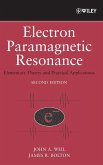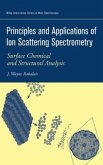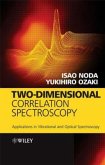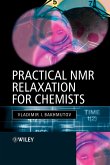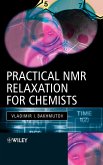Helmut H Telle, Angel González Ureña, Robert J Donovan
Laser Chemistry
Spectroscopy, Dynamics and Applications
Helmut H Telle, Angel González Ureña, Robert J Donovan
Laser Chemistry
Spectroscopy, Dynamics and Applications
- Broschiertes Buch
- Merkliste
- Auf die Merkliste
- Bewerten Bewerten
- Teilen
- Produkt teilen
- Produkterinnerung
- Produkterinnerung
Laser Chemistry: Spectroscopy, Dynamics and Applications is a carefully structured introduction to the basic theory and concepts of this subject. Assuming little in the way of prior knowledge, the book details underlying concepts and provides an overview of experimental techniques, supported by a broad range of case studies. Concentrating on molecular mechanisms and the fundamental nature of the phenomena, the book emphasises the basic science rather than presenting over-lengthy mathematical derivations and formalisms. After introducing concepts and methodologies, an extensive range of…mehr
Andere Kunden interessierten sich auch für
![Extreme Photonics & Applications Extreme Photonics & Applications]() Trevor J. Hall / Sergey V. Gaponenko (Hrsg.) Sofia . Sonstige Adaption von ParedesExtreme Photonics & Applications75,99 €
Trevor J. Hall / Sergey V. Gaponenko (Hrsg.) Sofia . Sonstige Adaption von ParedesExtreme Photonics & Applications75,99 €![Extreme Photonics & Applications Extreme Photonics & Applications]() Trevor J. Hall / Sergey V. Gaponenko (Hrsg.) Sofia A. . Sonstige Adaption von ParedesExtreme Photonics & Applications75,99 €
Trevor J. Hall / Sergey V. Gaponenko (Hrsg.) Sofia A. . Sonstige Adaption von ParedesExtreme Photonics & Applications75,99 €![Electron Paramagnetic Resonance Electron Paramagnetic Resonance]() John A. WeilElectron Paramagnetic Resonance254,99 €
John A. WeilElectron Paramagnetic Resonance254,99 €![Principles and Applications of Ion Scattering Spectrometry Principles and Applications of Ion Scattering Spectrometry]() J. Wayne RabalaisPrinciples and Applications of Ion Scattering Spectrometry192,99 €
J. Wayne RabalaisPrinciples and Applications of Ion Scattering Spectrometry192,99 €![Two-Dimensional Correlation Spectroscopy Two-Dimensional Correlation Spectroscopy]() Isao NodaTwo-Dimensional Correlation Spectroscopy281,99 €
Isao NodaTwo-Dimensional Correlation Spectroscopy281,99 €![Practical NMR Relaxation for Chemists Practical NMR Relaxation for Chemists]() Vladimir BakmutovPractical NMR Relaxation for Chemists121,99 €
Vladimir BakmutovPractical NMR Relaxation for Chemists121,99 €![Practical NMR Relaxation for Chemists Practical NMR Relaxation for Chemists]() Vladimir BakmutovPractical NMR Relaxation for Chemists287,99 €
Vladimir BakmutovPractical NMR Relaxation for Chemists287,99 €-
-
-
Laser Chemistry: Spectroscopy, Dynamics and Applications is a carefully structured introduction to the basic theory and concepts of this subject. Assuming little in the way of prior knowledge, the book details underlying concepts and provides an overview of experimental techniques, supported by a broad range of case studies. Concentrating on molecular mechanisms and the fundamental nature of the phenomena, the book emphasises the basic science rather than presenting over-lengthy mathematical derivations and formalisms. After introducing concepts and methodologies, an extensive range of examples in presented and discussed, covering spectroscopy, photochemistry, gas-phase, cluster, solution and surface reaction dynamics, analytical chemistry, medical chemistry and environmental chemistry. Additionally, a dedicated section on application is provided at the end of the book. * assumes little prior knowledge and avoids excessive mathematical rigour * detailed treatments and key issues are presented in separate boxes * concentrates on molecular mechanism and the fundamental nature of laser chemistry * provides an overview of experimental techniques and a broad range of case studies Laser Chemistry: Spectroscopy, Dynamics and Applications is a valuable reference for students of chemical physics, physical chemistry, photochemistry, laser spectroscopy and analytical chemistry.
Hinweis: Dieser Artikel kann nur an eine deutsche Lieferadresse ausgeliefert werden.
Hinweis: Dieser Artikel kann nur an eine deutsche Lieferadresse ausgeliefert werden.
Produktdetails
- Produktdetails
- Verlag: Wiley
- Seitenzahl: 520
- Erscheinungstermin: 1. Juni 2007
- Englisch
- Abmessung: 246mm x 189mm x 28mm
- Gewicht: 994g
- ISBN-13: 9780471485711
- ISBN-10: 0471485713
- Artikelnr.: 22716066
- Herstellerkennzeichnung
- Libri GmbH
- Europaallee 1
- 36244 Bad Hersfeld
- gpsr@libri.de
- Verlag: Wiley
- Seitenzahl: 520
- Erscheinungstermin: 1. Juni 2007
- Englisch
- Abmessung: 246mm x 189mm x 28mm
- Gewicht: 994g
- ISBN-13: 9780471485711
- ISBN-10: 0471485713
- Artikelnr.: 22716066
- Herstellerkennzeichnung
- Libri GmbH
- Europaallee 1
- 36244 Bad Hersfeld
- gpsr@libri.de
Helmut H. Telle received BSc, MSc and PhD degrees in physics from the University of Koln (Germany), in 1972, 1974 and 1979 respectively. Between 1980 and 1984 he spent research periods at the Department of Chemistry, University of Toronto (Canada), the Centre d' Etude Nucleaire de Saclay (France) and the Laboratoire des Interactions Ioniques, University of Marseille (France), Where he was mainly engaged in research on molecular reaction dynamics exploiting laser spectroscopic techniques. Since 1984 he has been Professor for Laser Physics in the Department of Physics, Swansea University (Wales, UK), where he has pursued research and development of laser systems and spectroscopic techniques for trace detection of atomic and molecular species, applied to analytical problems in industry, biomedicine and the environment. His expertise includes the techniques of laser-induced breakdown spectroscopy (LIBS), tuneable diode laser absorption spectroscopy (TDLAS), resonant ionization mass spectrometry (RIMS) and Raman and Near-field scanning optical microscopy (NSOM). More recently, he has once again returned to his roots associated with fundamental aspects in atomic and molecular physics, ranging from precision spectroscopy of exotic species, like positronium and anti-hydrogen, to probing of reactions at surfaces utilizing ultra-short laser pulses. He has held visiting appointments at the Centro de Investigacion en Optica, Leon (Mexico), the Universidad Complutense de Madrid (Spain) and at the Katholieke Universiteit Leuven (Belgium). Angel Gonzalez Urena obtained a chemistry degree from the University of Granada (Spain) in 1968, followed by a PhD in Physical Chemistry from the Complutense University (Madrid, Spain) in 1972. During the period 1972-1974 he worked in the fields of molecular beam and reaction dynamics at the Universities of Madison (Wisconsin, USA) and Austin (Texas, USA), and in later years at universities in the UK. He became Associate Professor in Chemical Physics in 1974 and Full Professor in 1983, both at the Completeness University of Madrid. His research interests focus mainly on gas-phase, cluster and surface reaction dynamics, using molecular beam and laser techniques. He was one of the pioneers in measuring threshold energies in chemical reactivity when changing the translational and electronic energy of the reactants, as well as in the measurements of high-resolution spectroscopy in intra-cluster reactions. More recently, his interests have branched out into the application of laser technologies to Analytical Chemistry, Environmental Chemistry, Biology and Food Science. he is the head of the Department of Molecular Beams and Lasers at the Institution Pluridisciplinar (Complutense University, Madrid); for the first 10 years of the institute's existence he also was its first director. He has held visiting appointments at Cambridge University (UK), at the universite de Paris Sud (France) and at the Academia Sinica, Taiwan National University (Taipei, Taiwan). Robert J. Donovan Graduated (BSc Hons) from the University of Wales in 1962. Following a year in industry, with Procter and Gamble appointed a Research Fellow of Gonville and Caius College (Cambridge) in 1966, and in 1970 he moved to the Department of Chemsitry at the University of Edinburgh. In 1979 he was appointed Professor of Physical Chemistry, and in 1986 he was appointed to the Foundation (1713) Chair of Chemistry at Edinburgh. His research interests lie in the fields of gas-phase energy transfer, photochemistry, reaction dynamics, spectroscopy and atmospheric chemistry. He was one of the pioneers of kinetic spectroscopy in the vacuum ultraviolet and has contributed substantially to the use of lasers and synchrotron radiation for the study of chemical and physical processes involving electronically excited states. His work in the field of spectroscopy has involved extensive studies of Rydberg, ionic and charge-transfer states, using optical-optical double resonance (OODR), resonance-enhanced multiphoto ionization (REMPI) and zero kinetic energy (ZEKE) photoelectron spectroscopy. In addition, he has applied laser techniques to a number of analytical areas, including LIBS, matrix-assisted laser desorption and ionization (MALDI) and aerosol mass spectrometry (AMS). He has held visiting appointments at the Universities of Alberta (Canada), Gottingen (Germany), Canterbury (New Zealand), the Australian National University at Canberra, the Tokyo Institute of Technology and the Institute for Molecular Science (Okazaki, Japan).
Preface.
About the authors.
Chapter 1 Introduction.
1.1 Basic concepts in laser chemistry.
1.2 Organization of the book.
Part 1 Principles of lasers and laser systems.
Chapter 2 Atoms and molecules, and their interaction with light waves.
2.1 Quantum states, energy levels and wave functions.
2.2 Dipole transitions and transition probabilities.
2.3 Einstein coefficients and excited-state lifetimes.
2.4 Spectroscopic line shapes.
2.5 The polarization of light waves.
2.6 Basic concepts of coherence.
2.7 Coherent superposition of quantum states and the concept of wave
packets.
Chapter 3 The basics of lasers.
3.1 Fundamentals of laser action.
3.2 Laser resonators.
3.3 Frequency and spatial properties of laser radiation.
3.4 Gain in continuous-wave and pulsed lasers.
3.5 Q-switching and the generation of nanosecond pulses.
3.6 Mode locking and the generation of picosecond and femtosecond pulses.
Chapter 4 Laser systems.
4.1 Fixed-wavelength gas lasers: helium-neon, rare-gas ion and excimer
lasers.
4.2 Fixed-wavelength solid-state lasers: the Nd:YAG laser.
4.3 Tuneable dye laser systems.
4.4 Tuneable Ti:sapphire laser systems.
4.5 Semiconductor diode lasers.
4.6 Quantum cascade lasers.
4.7 Non-linear crystals and frequency-mixing processes.
4.8 Three-wave mixing processes: doubling, sum and difference frequency
generation.
4.9 Optical parametric oscillation.
Part 2 Spectroscopic techniques in laser chemistry.
Chapter 5 General concepts of laser spectroscopy.
5.1 Spectroscopy based on photon detection.
5.2 Spectroscopy based on charged particle detection.
5.3 Spectroscopy based on measuring changes of macroscopic physical
properties of the medium.
Chapter 6 Absorption spectroscopy.
6.1 Principles of absorption spectroscopy.
6.2 Observable transitions in atoms and molecules.
6.3 Practical implementation of absorption spectroscopy.
6.4 Multipass absorption techniques.
Chapter 7 Laser-induced fluorescence spectroscopy.
7.1 Principles of laser-induced fluorescence spectroscopy.
7.2 Important parameters in laser-induced fluorescence.
7.3 Practical implementation of laser-induced fluorescence spectroscopy.
Chapter 8 Light scattering methods: Raman spectroscopy and other processes.
8.1 Light scattering.
8.2 Principles of Raman spectroscopy.
8.3 Practical implementation of Raman spectroscopy.
Chapter 9 Ionization spectroscopy.
9.1 Principles of ionization spectroscopy.
9.2 Photoion detection.
9.3 Photoelectron detection.
9.4 Photoion imaging.
Part 3 Optics and measurement concepts.
Chapter 10 Reflection, refraction and diffraction.
10.1 Selected properties of optical materials and light waves.
10.2 Reflection and refraction at a plane surface.
10.3 Light transmission through prisms.
10.4 Light transmission through lenses and imaging.
10.5 Imaging using curved mirrors.
10.6 Superposition, interference and diffraction of light waves.
10.7 Diffraction by single and multiple apertures.
10.8 Diffraction gratings.
Chapter 11 Filters and thin-film coatings.
11.1 Attenuation of light beams.
11.1 Beam splitters.
11.3 Wavelength-selective filters.
11.4 Polarization filters.
11.5 Reflection and filtering at optical component interfaces.
11.6 Thin-film coatings.
Chapter 12 Optical fibres.
12.1 Principles of optical fibre transmission.
12.2 Attenuation in fibre transmission.
12.3 Mode propagation in fibres.
Chapter 13 Analysis instrumentation and detectors.
13.1 Spectrometers.
13.2 Interferometers.
13.3 Photon detectors exploiting the photoelectric effect.
13.4 Photodetectors based on band-gap materials.
13.5 Measuring laser power and pulse energy.
13.6 Analysis of charged particles for charge, mass and energy.
13.7 Charged-particle detection.
Chapter 14 Signal processing and data acquisition.
14.1 Signals, noise and noise reduction.
14.2 DC, AC and balanced detection methods.
14.3 Lock-in detection techniques.
14.4 Gated integration/boxcar averaging techniques.
14.5 Event counting.
14.6 Digital conversion and data acquisition.
Part 4 Laser studies of photodissociation, photoionization and unimolecular
processes.
Chapter 15 Photodissociation of diatomic molecules.
15.1 Photofragment kinetic energy.
15.2 Angular distributions and anisotropic scattering.
15.3 Predissociation and curve crossing.
15.4 Femtosecond studies: chemistry in the fast lane.
15.5 Dissociation and oscillatory continuum emission.
Chapter 16 Photodissociation of triatomic molecules.
16.1 Photodissociation of water.
16.2 Photodissociation of ozone.
16.3 Laser-induced fluorescence and cavity ring-down studies.
16.4 Femtosecond studies: transition-state spectroscopy.
Chapter 17 Photodissociation of larger polyatomic molecules: energy
landscapes.
17.1 Rydberg tagging.
17.2 Photodissociation of ammonia.
17.3 Selective bond breaking.
17.4 Molecular elimination and three-body dissociation.
Chapter 18 Multiple and multiphoton excitation, and photoionization.
18.1 Infrared multiple-photon activation and unimolecular dissociation.
18.2 Continuum intermediate states and bond stretching.
18.3 High-resolution zero kinetic energy photoelectron spectroscopy.
18.4 Autoionization.
18.5 Photoion-pair formation.
Chapter 19. Coherent control and the future of ultra-short probing.
19.1 Coherent control of chemical processes.
19.2 The future of attosecond probing.
Part 5 Laser studies of bimolecular reactions.
Chapter 20 Basic concepts of kinetics and reaction dynamics.
20.1 Résumé of kinetics.
20.2 Introduction to reaction dynamics: total and differential reaction
cross-section.
20.3 Connection between dynamics and kinetics.
20.4 Basic concepts of potential energy surfaces.
20.5 Calculating potential energy surfaces.
Chapter 21 The molecular beam method: basic concepts and examples of
bimolecular reaction studies.
21.1 Basic concepts.
21.2 Interpretation of spatial and energy distributions: dynamics of a
two-body collision.
21.3 Interpretation of spatial and energy distributions: products angular
and velocity distributions as a route to the reaction mechanism.
Chapter 22 Chemical reactions with laser-prepared reagents.
22.1 Energy selectivity: mode-selective chemistry.
22.2 Energy selectivity: electronic excitation.
22.3 Stereodynamical effects with laser-prepared reagents.
22.4 Vibrationally excited reagents and their effect on stereo-dynamics.
Chapter 23 Laser probing of chemical reaction products.
23.1 Where does the energy of a chemical reaction go?
23.2 Probing the product state distribution of a chemical reaction.
23.3 Crossed-beam techniques and laser spectroscopic detection: towards the
state-to-state differential reaction cross-section measurements.
Part 6 Laser studies of cluster and surface reactions.
Chapter 24 Laser studies of complexes: van der Waals and cluster reactions.
24.1. Experimental set-ups and methodologies.
24.2. Metal-containing complexes.
24.3. Non-metal van der Waals complexes.
Chapter 25 Solvation dynamics: elementary reactions in solvent cages.
25.1. Dissociation of clusters containing I2.
25.2. Dissociation of clusters containing I2.
25.3. Proton-transfer reactions.
Chapter 26 Laser studies of surface reactions: an introduction.
26.1. Résumé of metal surface properties and electronic structure.
26.2. Particle-surface interaction.
26.3. Surface reaction mechanisms.
26.4. Experimental methods to investigate laser-induced surface reactions.
Chapter 27¿Laser studies of surface reactions: photochemistry in the
adsorbed state.
27.1. Adsorbate- versus substrate-mediated processes.
27.2. Examples of photoinduced reactions in the adsorbed state.
27.3. Femto-chemistry at surfaces: the ultrafast reaction CO/O-[Ru(0001)].
Part 7 Selected applications.
Chapter 28 Environmental and other analytical applications.
28.1 Atmospheric gas monitoring using tuneable diode laser absorption
spectroscopy.
28.2 Closed-path tuneable diode laser absorption spectroscopy applications.
28.3 Open-path tuneable diode laser absorption spectroscopy applications.
28.4 The lidar technique for remote gas analysis.
28.5 Lidar in the study of atmospheric chemistry: tropospheric
measurements.
28.6 Lidar in the study of atmospheric chemistry: stratospheric
measurements.
28.7 Laser desorption and ionization: laser-induced breakdown spectroscopy,
matrix-assisted laser desorption and ionization, and aerosol time-of-flight
mass spectrometry.
Chapter 29 Industrial monitoring and process control.
29.1 Analysis of internal combustion engines.
29.2 Laser-spectroscopic analysis of burners and incinerators.
29.3 Laser-chemical processes at surfaces: nanoscale patterning.
Chapter 30 Laser applications in medicine and biology.
30.1 Photodynamic therapy.
30.2 Intra-cell mapping of drug delivery using Raman imaging.
30.3 Breath diagnostics using laser spectroscopy.
30.4 From photons to plant defence mechanisms.
30.5 Application to volatile compounds: on-line detection of plant stress.
30.6 Laser applications to the study of non-volatile compounds in fruits.
References.
References grouped by chapter.
Further reading grouped by part.
Web pages.
Appendix.
Common abbreviations and acronyms.
Physical constants.
Useful conversions and other relationships.
Energy conversion factors.
Index.
About the authors.
Chapter 1 Introduction.
1.1 Basic concepts in laser chemistry.
1.2 Organization of the book.
Part 1 Principles of lasers and laser systems.
Chapter 2 Atoms and molecules, and their interaction with light waves.
2.1 Quantum states, energy levels and wave functions.
2.2 Dipole transitions and transition probabilities.
2.3 Einstein coefficients and excited-state lifetimes.
2.4 Spectroscopic line shapes.
2.5 The polarization of light waves.
2.6 Basic concepts of coherence.
2.7 Coherent superposition of quantum states and the concept of wave
packets.
Chapter 3 The basics of lasers.
3.1 Fundamentals of laser action.
3.2 Laser resonators.
3.3 Frequency and spatial properties of laser radiation.
3.4 Gain in continuous-wave and pulsed lasers.
3.5 Q-switching and the generation of nanosecond pulses.
3.6 Mode locking and the generation of picosecond and femtosecond pulses.
Chapter 4 Laser systems.
4.1 Fixed-wavelength gas lasers: helium-neon, rare-gas ion and excimer
lasers.
4.2 Fixed-wavelength solid-state lasers: the Nd:YAG laser.
4.3 Tuneable dye laser systems.
4.4 Tuneable Ti:sapphire laser systems.
4.5 Semiconductor diode lasers.
4.6 Quantum cascade lasers.
4.7 Non-linear crystals and frequency-mixing processes.
4.8 Three-wave mixing processes: doubling, sum and difference frequency
generation.
4.9 Optical parametric oscillation.
Part 2 Spectroscopic techniques in laser chemistry.
Chapter 5 General concepts of laser spectroscopy.
5.1 Spectroscopy based on photon detection.
5.2 Spectroscopy based on charged particle detection.
5.3 Spectroscopy based on measuring changes of macroscopic physical
properties of the medium.
Chapter 6 Absorption spectroscopy.
6.1 Principles of absorption spectroscopy.
6.2 Observable transitions in atoms and molecules.
6.3 Practical implementation of absorption spectroscopy.
6.4 Multipass absorption techniques.
Chapter 7 Laser-induced fluorescence spectroscopy.
7.1 Principles of laser-induced fluorescence spectroscopy.
7.2 Important parameters in laser-induced fluorescence.
7.3 Practical implementation of laser-induced fluorescence spectroscopy.
Chapter 8 Light scattering methods: Raman spectroscopy and other processes.
8.1 Light scattering.
8.2 Principles of Raman spectroscopy.
8.3 Practical implementation of Raman spectroscopy.
Chapter 9 Ionization spectroscopy.
9.1 Principles of ionization spectroscopy.
9.2 Photoion detection.
9.3 Photoelectron detection.
9.4 Photoion imaging.
Part 3 Optics and measurement concepts.
Chapter 10 Reflection, refraction and diffraction.
10.1 Selected properties of optical materials and light waves.
10.2 Reflection and refraction at a plane surface.
10.3 Light transmission through prisms.
10.4 Light transmission through lenses and imaging.
10.5 Imaging using curved mirrors.
10.6 Superposition, interference and diffraction of light waves.
10.7 Diffraction by single and multiple apertures.
10.8 Diffraction gratings.
Chapter 11 Filters and thin-film coatings.
11.1 Attenuation of light beams.
11.1 Beam splitters.
11.3 Wavelength-selective filters.
11.4 Polarization filters.
11.5 Reflection and filtering at optical component interfaces.
11.6 Thin-film coatings.
Chapter 12 Optical fibres.
12.1 Principles of optical fibre transmission.
12.2 Attenuation in fibre transmission.
12.3 Mode propagation in fibres.
Chapter 13 Analysis instrumentation and detectors.
13.1 Spectrometers.
13.2 Interferometers.
13.3 Photon detectors exploiting the photoelectric effect.
13.4 Photodetectors based on band-gap materials.
13.5 Measuring laser power and pulse energy.
13.6 Analysis of charged particles for charge, mass and energy.
13.7 Charged-particle detection.
Chapter 14 Signal processing and data acquisition.
14.1 Signals, noise and noise reduction.
14.2 DC, AC and balanced detection methods.
14.3 Lock-in detection techniques.
14.4 Gated integration/boxcar averaging techniques.
14.5 Event counting.
14.6 Digital conversion and data acquisition.
Part 4 Laser studies of photodissociation, photoionization and unimolecular
processes.
Chapter 15 Photodissociation of diatomic molecules.
15.1 Photofragment kinetic energy.
15.2 Angular distributions and anisotropic scattering.
15.3 Predissociation and curve crossing.
15.4 Femtosecond studies: chemistry in the fast lane.
15.5 Dissociation and oscillatory continuum emission.
Chapter 16 Photodissociation of triatomic molecules.
16.1 Photodissociation of water.
16.2 Photodissociation of ozone.
16.3 Laser-induced fluorescence and cavity ring-down studies.
16.4 Femtosecond studies: transition-state spectroscopy.
Chapter 17 Photodissociation of larger polyatomic molecules: energy
landscapes.
17.1 Rydberg tagging.
17.2 Photodissociation of ammonia.
17.3 Selective bond breaking.
17.4 Molecular elimination and three-body dissociation.
Chapter 18 Multiple and multiphoton excitation, and photoionization.
18.1 Infrared multiple-photon activation and unimolecular dissociation.
18.2 Continuum intermediate states and bond stretching.
18.3 High-resolution zero kinetic energy photoelectron spectroscopy.
18.4 Autoionization.
18.5 Photoion-pair formation.
Chapter 19. Coherent control and the future of ultra-short probing.
19.1 Coherent control of chemical processes.
19.2 The future of attosecond probing.
Part 5 Laser studies of bimolecular reactions.
Chapter 20 Basic concepts of kinetics and reaction dynamics.
20.1 Résumé of kinetics.
20.2 Introduction to reaction dynamics: total and differential reaction
cross-section.
20.3 Connection between dynamics and kinetics.
20.4 Basic concepts of potential energy surfaces.
20.5 Calculating potential energy surfaces.
Chapter 21 The molecular beam method: basic concepts and examples of
bimolecular reaction studies.
21.1 Basic concepts.
21.2 Interpretation of spatial and energy distributions: dynamics of a
two-body collision.
21.3 Interpretation of spatial and energy distributions: products angular
and velocity distributions as a route to the reaction mechanism.
Chapter 22 Chemical reactions with laser-prepared reagents.
22.1 Energy selectivity: mode-selective chemistry.
22.2 Energy selectivity: electronic excitation.
22.3 Stereodynamical effects with laser-prepared reagents.
22.4 Vibrationally excited reagents and their effect on stereo-dynamics.
Chapter 23 Laser probing of chemical reaction products.
23.1 Where does the energy of a chemical reaction go?
23.2 Probing the product state distribution of a chemical reaction.
23.3 Crossed-beam techniques and laser spectroscopic detection: towards the
state-to-state differential reaction cross-section measurements.
Part 6 Laser studies of cluster and surface reactions.
Chapter 24 Laser studies of complexes: van der Waals and cluster reactions.
24.1. Experimental set-ups and methodologies.
24.2. Metal-containing complexes.
24.3. Non-metal van der Waals complexes.
Chapter 25 Solvation dynamics: elementary reactions in solvent cages.
25.1. Dissociation of clusters containing I2.
25.2. Dissociation of clusters containing I2.
25.3. Proton-transfer reactions.
Chapter 26 Laser studies of surface reactions: an introduction.
26.1. Résumé of metal surface properties and electronic structure.
26.2. Particle-surface interaction.
26.3. Surface reaction mechanisms.
26.4. Experimental methods to investigate laser-induced surface reactions.
Chapter 27¿Laser studies of surface reactions: photochemistry in the
adsorbed state.
27.1. Adsorbate- versus substrate-mediated processes.
27.2. Examples of photoinduced reactions in the adsorbed state.
27.3. Femto-chemistry at surfaces: the ultrafast reaction CO/O-[Ru(0001)].
Part 7 Selected applications.
Chapter 28 Environmental and other analytical applications.
28.1 Atmospheric gas monitoring using tuneable diode laser absorption
spectroscopy.
28.2 Closed-path tuneable diode laser absorption spectroscopy applications.
28.3 Open-path tuneable diode laser absorption spectroscopy applications.
28.4 The lidar technique for remote gas analysis.
28.5 Lidar in the study of atmospheric chemistry: tropospheric
measurements.
28.6 Lidar in the study of atmospheric chemistry: stratospheric
measurements.
28.7 Laser desorption and ionization: laser-induced breakdown spectroscopy,
matrix-assisted laser desorption and ionization, and aerosol time-of-flight
mass spectrometry.
Chapter 29 Industrial monitoring and process control.
29.1 Analysis of internal combustion engines.
29.2 Laser-spectroscopic analysis of burners and incinerators.
29.3 Laser-chemical processes at surfaces: nanoscale patterning.
Chapter 30 Laser applications in medicine and biology.
30.1 Photodynamic therapy.
30.2 Intra-cell mapping of drug delivery using Raman imaging.
30.3 Breath diagnostics using laser spectroscopy.
30.4 From photons to plant defence mechanisms.
30.5 Application to volatile compounds: on-line detection of plant stress.
30.6 Laser applications to the study of non-volatile compounds in fruits.
References.
References grouped by chapter.
Further reading grouped by part.
Web pages.
Appendix.
Common abbreviations and acronyms.
Physical constants.
Useful conversions and other relationships.
Energy conversion factors.
Index.
Preface.
About the authors.
Chapter 1 Introduction.
1.1 Basic concepts in laser chemistry.
1.2 Organization of the book.
Part 1 Principles of lasers and laser systems.
Chapter 2 Atoms and molecules, and their interaction with light waves.
2.1 Quantum states, energy levels and wave functions.
2.2 Dipole transitions and transition probabilities.
2.3 Einstein coefficients and excited-state lifetimes.
2.4 Spectroscopic line shapes.
2.5 The polarization of light waves.
2.6 Basic concepts of coherence.
2.7 Coherent superposition of quantum states and the concept of wave
packets.
Chapter 3 The basics of lasers.
3.1 Fundamentals of laser action.
3.2 Laser resonators.
3.3 Frequency and spatial properties of laser radiation.
3.4 Gain in continuous-wave and pulsed lasers.
3.5 Q-switching and the generation of nanosecond pulses.
3.6 Mode locking and the generation of picosecond and femtosecond pulses.
Chapter 4 Laser systems.
4.1 Fixed-wavelength gas lasers: helium-neon, rare-gas ion and excimer
lasers.
4.2 Fixed-wavelength solid-state lasers: the Nd:YAG laser.
4.3 Tuneable dye laser systems.
4.4 Tuneable Ti:sapphire laser systems.
4.5 Semiconductor diode lasers.
4.6 Quantum cascade lasers.
4.7 Non-linear crystals and frequency-mixing processes.
4.8 Three-wave mixing processes: doubling, sum and difference frequency
generation.
4.9 Optical parametric oscillation.
Part 2 Spectroscopic techniques in laser chemistry.
Chapter 5 General concepts of laser spectroscopy.
5.1 Spectroscopy based on photon detection.
5.2 Spectroscopy based on charged particle detection.
5.3 Spectroscopy based on measuring changes of macroscopic physical
properties of the medium.
Chapter 6 Absorption spectroscopy.
6.1 Principles of absorption spectroscopy.
6.2 Observable transitions in atoms and molecules.
6.3 Practical implementation of absorption spectroscopy.
6.4 Multipass absorption techniques.
Chapter 7 Laser-induced fluorescence spectroscopy.
7.1 Principles of laser-induced fluorescence spectroscopy.
7.2 Important parameters in laser-induced fluorescence.
7.3 Practical implementation of laser-induced fluorescence spectroscopy.
Chapter 8 Light scattering methods: Raman spectroscopy and other processes.
8.1 Light scattering.
8.2 Principles of Raman spectroscopy.
8.3 Practical implementation of Raman spectroscopy.
Chapter 9 Ionization spectroscopy.
9.1 Principles of ionization spectroscopy.
9.2 Photoion detection.
9.3 Photoelectron detection.
9.4 Photoion imaging.
Part 3 Optics and measurement concepts.
Chapter 10 Reflection, refraction and diffraction.
10.1 Selected properties of optical materials and light waves.
10.2 Reflection and refraction at a plane surface.
10.3 Light transmission through prisms.
10.4 Light transmission through lenses and imaging.
10.5 Imaging using curved mirrors.
10.6 Superposition, interference and diffraction of light waves.
10.7 Diffraction by single and multiple apertures.
10.8 Diffraction gratings.
Chapter 11 Filters and thin-film coatings.
11.1 Attenuation of light beams.
11.1 Beam splitters.
11.3 Wavelength-selective filters.
11.4 Polarization filters.
11.5 Reflection and filtering at optical component interfaces.
11.6 Thin-film coatings.
Chapter 12 Optical fibres.
12.1 Principles of optical fibre transmission.
12.2 Attenuation in fibre transmission.
12.3 Mode propagation in fibres.
Chapter 13 Analysis instrumentation and detectors.
13.1 Spectrometers.
13.2 Interferometers.
13.3 Photon detectors exploiting the photoelectric effect.
13.4 Photodetectors based on band-gap materials.
13.5 Measuring laser power and pulse energy.
13.6 Analysis of charged particles for charge, mass and energy.
13.7 Charged-particle detection.
Chapter 14 Signal processing and data acquisition.
14.1 Signals, noise and noise reduction.
14.2 DC, AC and balanced detection methods.
14.3 Lock-in detection techniques.
14.4 Gated integration/boxcar averaging techniques.
14.5 Event counting.
14.6 Digital conversion and data acquisition.
Part 4 Laser studies of photodissociation, photoionization and unimolecular
processes.
Chapter 15 Photodissociation of diatomic molecules.
15.1 Photofragment kinetic energy.
15.2 Angular distributions and anisotropic scattering.
15.3 Predissociation and curve crossing.
15.4 Femtosecond studies: chemistry in the fast lane.
15.5 Dissociation and oscillatory continuum emission.
Chapter 16 Photodissociation of triatomic molecules.
16.1 Photodissociation of water.
16.2 Photodissociation of ozone.
16.3 Laser-induced fluorescence and cavity ring-down studies.
16.4 Femtosecond studies: transition-state spectroscopy.
Chapter 17 Photodissociation of larger polyatomic molecules: energy
landscapes.
17.1 Rydberg tagging.
17.2 Photodissociation of ammonia.
17.3 Selective bond breaking.
17.4 Molecular elimination and three-body dissociation.
Chapter 18 Multiple and multiphoton excitation, and photoionization.
18.1 Infrared multiple-photon activation and unimolecular dissociation.
18.2 Continuum intermediate states and bond stretching.
18.3 High-resolution zero kinetic energy photoelectron spectroscopy.
18.4 Autoionization.
18.5 Photoion-pair formation.
Chapter 19. Coherent control and the future of ultra-short probing.
19.1 Coherent control of chemical processes.
19.2 The future of attosecond probing.
Part 5 Laser studies of bimolecular reactions.
Chapter 20 Basic concepts of kinetics and reaction dynamics.
20.1 Résumé of kinetics.
20.2 Introduction to reaction dynamics: total and differential reaction
cross-section.
20.3 Connection between dynamics and kinetics.
20.4 Basic concepts of potential energy surfaces.
20.5 Calculating potential energy surfaces.
Chapter 21 The molecular beam method: basic concepts and examples of
bimolecular reaction studies.
21.1 Basic concepts.
21.2 Interpretation of spatial and energy distributions: dynamics of a
two-body collision.
21.3 Interpretation of spatial and energy distributions: products angular
and velocity distributions as a route to the reaction mechanism.
Chapter 22 Chemical reactions with laser-prepared reagents.
22.1 Energy selectivity: mode-selective chemistry.
22.2 Energy selectivity: electronic excitation.
22.3 Stereodynamical effects with laser-prepared reagents.
22.4 Vibrationally excited reagents and their effect on stereo-dynamics.
Chapter 23 Laser probing of chemical reaction products.
23.1 Where does the energy of a chemical reaction go?
23.2 Probing the product state distribution of a chemical reaction.
23.3 Crossed-beam techniques and laser spectroscopic detection: towards the
state-to-state differential reaction cross-section measurements.
Part 6 Laser studies of cluster and surface reactions.
Chapter 24 Laser studies of complexes: van der Waals and cluster reactions.
24.1. Experimental set-ups and methodologies.
24.2. Metal-containing complexes.
24.3. Non-metal van der Waals complexes.
Chapter 25 Solvation dynamics: elementary reactions in solvent cages.
25.1. Dissociation of clusters containing I2.
25.2. Dissociation of clusters containing I2.
25.3. Proton-transfer reactions.
Chapter 26 Laser studies of surface reactions: an introduction.
26.1. Résumé of metal surface properties and electronic structure.
26.2. Particle-surface interaction.
26.3. Surface reaction mechanisms.
26.4. Experimental methods to investigate laser-induced surface reactions.
Chapter 27¿Laser studies of surface reactions: photochemistry in the
adsorbed state.
27.1. Adsorbate- versus substrate-mediated processes.
27.2. Examples of photoinduced reactions in the adsorbed state.
27.3. Femto-chemistry at surfaces: the ultrafast reaction CO/O-[Ru(0001)].
Part 7 Selected applications.
Chapter 28 Environmental and other analytical applications.
28.1 Atmospheric gas monitoring using tuneable diode laser absorption
spectroscopy.
28.2 Closed-path tuneable diode laser absorption spectroscopy applications.
28.3 Open-path tuneable diode laser absorption spectroscopy applications.
28.4 The lidar technique for remote gas analysis.
28.5 Lidar in the study of atmospheric chemistry: tropospheric
measurements.
28.6 Lidar in the study of atmospheric chemistry: stratospheric
measurements.
28.7 Laser desorption and ionization: laser-induced breakdown spectroscopy,
matrix-assisted laser desorption and ionization, and aerosol time-of-flight
mass spectrometry.
Chapter 29 Industrial monitoring and process control.
29.1 Analysis of internal combustion engines.
29.2 Laser-spectroscopic analysis of burners and incinerators.
29.3 Laser-chemical processes at surfaces: nanoscale patterning.
Chapter 30 Laser applications in medicine and biology.
30.1 Photodynamic therapy.
30.2 Intra-cell mapping of drug delivery using Raman imaging.
30.3 Breath diagnostics using laser spectroscopy.
30.4 From photons to plant defence mechanisms.
30.5 Application to volatile compounds: on-line detection of plant stress.
30.6 Laser applications to the study of non-volatile compounds in fruits.
References.
References grouped by chapter.
Further reading grouped by part.
Web pages.
Appendix.
Common abbreviations and acronyms.
Physical constants.
Useful conversions and other relationships.
Energy conversion factors.
Index.
About the authors.
Chapter 1 Introduction.
1.1 Basic concepts in laser chemistry.
1.2 Organization of the book.
Part 1 Principles of lasers and laser systems.
Chapter 2 Atoms and molecules, and their interaction with light waves.
2.1 Quantum states, energy levels and wave functions.
2.2 Dipole transitions and transition probabilities.
2.3 Einstein coefficients and excited-state lifetimes.
2.4 Spectroscopic line shapes.
2.5 The polarization of light waves.
2.6 Basic concepts of coherence.
2.7 Coherent superposition of quantum states and the concept of wave
packets.
Chapter 3 The basics of lasers.
3.1 Fundamentals of laser action.
3.2 Laser resonators.
3.3 Frequency and spatial properties of laser radiation.
3.4 Gain in continuous-wave and pulsed lasers.
3.5 Q-switching and the generation of nanosecond pulses.
3.6 Mode locking and the generation of picosecond and femtosecond pulses.
Chapter 4 Laser systems.
4.1 Fixed-wavelength gas lasers: helium-neon, rare-gas ion and excimer
lasers.
4.2 Fixed-wavelength solid-state lasers: the Nd:YAG laser.
4.3 Tuneable dye laser systems.
4.4 Tuneable Ti:sapphire laser systems.
4.5 Semiconductor diode lasers.
4.6 Quantum cascade lasers.
4.7 Non-linear crystals and frequency-mixing processes.
4.8 Three-wave mixing processes: doubling, sum and difference frequency
generation.
4.9 Optical parametric oscillation.
Part 2 Spectroscopic techniques in laser chemistry.
Chapter 5 General concepts of laser spectroscopy.
5.1 Spectroscopy based on photon detection.
5.2 Spectroscopy based on charged particle detection.
5.3 Spectroscopy based on measuring changes of macroscopic physical
properties of the medium.
Chapter 6 Absorption spectroscopy.
6.1 Principles of absorption spectroscopy.
6.2 Observable transitions in atoms and molecules.
6.3 Practical implementation of absorption spectroscopy.
6.4 Multipass absorption techniques.
Chapter 7 Laser-induced fluorescence spectroscopy.
7.1 Principles of laser-induced fluorescence spectroscopy.
7.2 Important parameters in laser-induced fluorescence.
7.3 Practical implementation of laser-induced fluorescence spectroscopy.
Chapter 8 Light scattering methods: Raman spectroscopy and other processes.
8.1 Light scattering.
8.2 Principles of Raman spectroscopy.
8.3 Practical implementation of Raman spectroscopy.
Chapter 9 Ionization spectroscopy.
9.1 Principles of ionization spectroscopy.
9.2 Photoion detection.
9.3 Photoelectron detection.
9.4 Photoion imaging.
Part 3 Optics and measurement concepts.
Chapter 10 Reflection, refraction and diffraction.
10.1 Selected properties of optical materials and light waves.
10.2 Reflection and refraction at a plane surface.
10.3 Light transmission through prisms.
10.4 Light transmission through lenses and imaging.
10.5 Imaging using curved mirrors.
10.6 Superposition, interference and diffraction of light waves.
10.7 Diffraction by single and multiple apertures.
10.8 Diffraction gratings.
Chapter 11 Filters and thin-film coatings.
11.1 Attenuation of light beams.
11.1 Beam splitters.
11.3 Wavelength-selective filters.
11.4 Polarization filters.
11.5 Reflection and filtering at optical component interfaces.
11.6 Thin-film coatings.
Chapter 12 Optical fibres.
12.1 Principles of optical fibre transmission.
12.2 Attenuation in fibre transmission.
12.3 Mode propagation in fibres.
Chapter 13 Analysis instrumentation and detectors.
13.1 Spectrometers.
13.2 Interferometers.
13.3 Photon detectors exploiting the photoelectric effect.
13.4 Photodetectors based on band-gap materials.
13.5 Measuring laser power and pulse energy.
13.6 Analysis of charged particles for charge, mass and energy.
13.7 Charged-particle detection.
Chapter 14 Signal processing and data acquisition.
14.1 Signals, noise and noise reduction.
14.2 DC, AC and balanced detection methods.
14.3 Lock-in detection techniques.
14.4 Gated integration/boxcar averaging techniques.
14.5 Event counting.
14.6 Digital conversion and data acquisition.
Part 4 Laser studies of photodissociation, photoionization and unimolecular
processes.
Chapter 15 Photodissociation of diatomic molecules.
15.1 Photofragment kinetic energy.
15.2 Angular distributions and anisotropic scattering.
15.3 Predissociation and curve crossing.
15.4 Femtosecond studies: chemistry in the fast lane.
15.5 Dissociation and oscillatory continuum emission.
Chapter 16 Photodissociation of triatomic molecules.
16.1 Photodissociation of water.
16.2 Photodissociation of ozone.
16.3 Laser-induced fluorescence and cavity ring-down studies.
16.4 Femtosecond studies: transition-state spectroscopy.
Chapter 17 Photodissociation of larger polyatomic molecules: energy
landscapes.
17.1 Rydberg tagging.
17.2 Photodissociation of ammonia.
17.3 Selective bond breaking.
17.4 Molecular elimination and three-body dissociation.
Chapter 18 Multiple and multiphoton excitation, and photoionization.
18.1 Infrared multiple-photon activation and unimolecular dissociation.
18.2 Continuum intermediate states and bond stretching.
18.3 High-resolution zero kinetic energy photoelectron spectroscopy.
18.4 Autoionization.
18.5 Photoion-pair formation.
Chapter 19. Coherent control and the future of ultra-short probing.
19.1 Coherent control of chemical processes.
19.2 The future of attosecond probing.
Part 5 Laser studies of bimolecular reactions.
Chapter 20 Basic concepts of kinetics and reaction dynamics.
20.1 Résumé of kinetics.
20.2 Introduction to reaction dynamics: total and differential reaction
cross-section.
20.3 Connection between dynamics and kinetics.
20.4 Basic concepts of potential energy surfaces.
20.5 Calculating potential energy surfaces.
Chapter 21 The molecular beam method: basic concepts and examples of
bimolecular reaction studies.
21.1 Basic concepts.
21.2 Interpretation of spatial and energy distributions: dynamics of a
two-body collision.
21.3 Interpretation of spatial and energy distributions: products angular
and velocity distributions as a route to the reaction mechanism.
Chapter 22 Chemical reactions with laser-prepared reagents.
22.1 Energy selectivity: mode-selective chemistry.
22.2 Energy selectivity: electronic excitation.
22.3 Stereodynamical effects with laser-prepared reagents.
22.4 Vibrationally excited reagents and their effect on stereo-dynamics.
Chapter 23 Laser probing of chemical reaction products.
23.1 Where does the energy of a chemical reaction go?
23.2 Probing the product state distribution of a chemical reaction.
23.3 Crossed-beam techniques and laser spectroscopic detection: towards the
state-to-state differential reaction cross-section measurements.
Part 6 Laser studies of cluster and surface reactions.
Chapter 24 Laser studies of complexes: van der Waals and cluster reactions.
24.1. Experimental set-ups and methodologies.
24.2. Metal-containing complexes.
24.3. Non-metal van der Waals complexes.
Chapter 25 Solvation dynamics: elementary reactions in solvent cages.
25.1. Dissociation of clusters containing I2.
25.2. Dissociation of clusters containing I2.
25.3. Proton-transfer reactions.
Chapter 26 Laser studies of surface reactions: an introduction.
26.1. Résumé of metal surface properties and electronic structure.
26.2. Particle-surface interaction.
26.3. Surface reaction mechanisms.
26.4. Experimental methods to investigate laser-induced surface reactions.
Chapter 27¿Laser studies of surface reactions: photochemistry in the
adsorbed state.
27.1. Adsorbate- versus substrate-mediated processes.
27.2. Examples of photoinduced reactions in the adsorbed state.
27.3. Femto-chemistry at surfaces: the ultrafast reaction CO/O-[Ru(0001)].
Part 7 Selected applications.
Chapter 28 Environmental and other analytical applications.
28.1 Atmospheric gas monitoring using tuneable diode laser absorption
spectroscopy.
28.2 Closed-path tuneable diode laser absorption spectroscopy applications.
28.3 Open-path tuneable diode laser absorption spectroscopy applications.
28.4 The lidar technique for remote gas analysis.
28.5 Lidar in the study of atmospheric chemistry: tropospheric
measurements.
28.6 Lidar in the study of atmospheric chemistry: stratospheric
measurements.
28.7 Laser desorption and ionization: laser-induced breakdown spectroscopy,
matrix-assisted laser desorption and ionization, and aerosol time-of-flight
mass spectrometry.
Chapter 29 Industrial monitoring and process control.
29.1 Analysis of internal combustion engines.
29.2 Laser-spectroscopic analysis of burners and incinerators.
29.3 Laser-chemical processes at surfaces: nanoscale patterning.
Chapter 30 Laser applications in medicine and biology.
30.1 Photodynamic therapy.
30.2 Intra-cell mapping of drug delivery using Raman imaging.
30.3 Breath diagnostics using laser spectroscopy.
30.4 From photons to plant defence mechanisms.
30.5 Application to volatile compounds: on-line detection of plant stress.
30.6 Laser applications to the study of non-volatile compounds in fruits.
References.
References grouped by chapter.
Further reading grouped by part.
Web pages.
Appendix.
Common abbreviations and acronyms.
Physical constants.
Useful conversions and other relationships.
Energy conversion factors.
Index.

